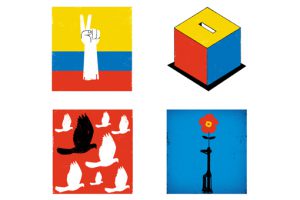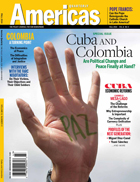
The Myths of the Colombian Peace Process
From its very beginning, Colombia’s peace process has aroused enormous expectations, not only within Colombian borders, but also in the international community. The negotiation is, in good measure, the result of the “Policy of Democratic Security” adopted by President Álvaro Uribe Vélez during his two terms (2002 to 2010), which helped limit the Fuerzas Armadas … Read more

Ask the Experts: Colombian Peace Process
Clem McCartney answers: Colombia has already had the foresight and wisdom to analyze the experience of other countries in bringing internal conflicts to an end—including South Africa, the Philippines and Northern Ireland. As I write, representatives of the conflicting parties in Northern Ireland have just finished meeting Colombian government and FARC negotiators. Perhaps the immediate … Read more
Monday Memo: Ecuador Amendments — P&G Tax Fraud — Brazil Solar Parks — U.S. Midterm Elections – Colombia Paramilitary Sentenced
This week’s likely top stories: Ecuador’s National Assembly dismisses referendum on controversial constitutional amendments; Argentina suspends Proctor & Gamble for fiscal fraud; Brazil grants contracts for 31 new solar parks; U.S. gears up for midterm elections and immigration reform; Colombian court sentences AUC paramilitary leader to 8 years. Ecuador’s National Assembly Strikes Down Referendum on … Read more

Cuba and Colombia
Articles: published article?1 A Skeptic’s View on the “Peace Dividend” by Alberto Bernal The economic benefits are neither direct nor certain. The Obstacles to Political Integration Post-Peace by Juanita León The obstacles to political integration. Full text available. Law and Reconciliation in Colombia by Rodrigo Uprimny Yepes and Nelson Camilo Sanchez Here’s how to achieve … Read more
Colombia Submits Action Plan to EITI Secretariat
The extraction of natural resources, such as oil, gas, metals and minerals, is supposed to boost the economy and improve the quality of life of the residents of resource rich countries. However, in too many cases, resource extraction has led to social inequality, environmental degradation and corruption. In places like Colombia, it aggravates conflict. The … Read more
Monday Memo: Canadian Executive Jailed – Missing Mexican students – Venezuelan Bolivar – Murder Suspects in Peru – Colombian Hackers
This week’s likely top stories: Canadian businessman Cy Tokmakjian is sentenced to 15 years in Cuba; Mexico searches for 58 missing students; Venezuela’s bolivar hits a new low; Peru arrests two suspects in the murder of Indigenous activists; Colombian peace negotiator Humberto de la Calle says his e-mail was hacked. Canadian executive jailed in Cuba: … Read more
Shale Gas Development in Latin America
New technology and capital has boosted shale gas and tight oil production in the United States and Canada—a phenomenon dubbed the “shale revolution.” This revolution has important geopolitical implications and has shifted North America’s energy outlook from one of scarcity to one of abundance. The rest of the Western Hemisphere is also sitting on expansive … Read more
Colombia Senate Debates Uribe Paramilitary Links
Colombian lawmakers accused former President Álvaro Uribe of links to right-wing paramilitary groups during a polemic Senate debate on Wednesday. Senator Ivan Cepeda led the questioning of Uribe during a 90-minute presentation in which he introduced documents supporting the former president’s alleged ties to paramilitary groups and drug cartels, including the Medellin Cartel financier Luis … Read more
Los Límites del Consejo de Defensa Suramericano
Entre el 14 y el 15 de agosto, en Cartagena de Indias, Colombia, el Consejo de Defensa Suramericano (CDS) llevó a cabo su reunión anual. Desde el momento en que Surinam fue seleccionada por rotación para presidir la Unión de Naciones Suramericanas (UNASUR), de acuerdo a entrevistas realizadas a funcionarios diplomáticos relacionados con la UNASUR, … Read more
FARC Addresses Reparations for Conflict Victims
In a press release Wednesday, the Fuerzas Armadas Revolucionarias de Colombia (Revolutionary Armed Forces of Colombia—FARC) announced that it would create a special fund for reparations for victims of the armed conflict. The group also asked the Colombian government to take tangible actions to protect the rights of said victims. The release came on the … Read more
Monday Memo: Santos’ Cabinet – Venezuela-Colombia Border – Codelco – Argentine Ex-Captain Deported – Pemex Fire
This week’s likely top stories: President Juan Manuel Santos announces new ministers; Venezuela and Colombia crack down on smuggling; Codelco’s CEO has new plans for Chuquicamata Mine; Bolivia deports an Argentine accused of crimes against humanity; a fire at a Pemex refinery kills at least four people. President Santos to announce new Cabinet: Colombian President … Read more
Santos to Continue Peace Process in Second Term
Colombian President Juan Manuel Santos began his second term yesterday after winning reelection in the second round in June, defeating Óscar Iván Zuluaga who was backed by former President Álvaro Uribe. Santos based his campaign on the promise of a peace, with the hope of coming to an agreement the left-wing guerrilla group Fuerzas Armadas … Read more
Mexico’s Energy Reform: Lessons from Colombia and Brazil
In the early 2000s, Colombia’s oil industry was weakening. There had been a decrease in new discoveries, followed by a decline in production from a peak of 800,000 barrels per day (b/d) in 1999 to nearly 550,000 b/d in 2004. Exploration and production had moved to increasingly remote areas with higher security risks and risky … Read more
Monday Memo: USAID and Cuba – Mexican Energy – U.S. Immigration – Argentine peso – Bridge in Colombia
This week’s top stories: USAID is accused of running a secret program in Cuba; Mexican energy reform passes in the lower house; U.S. Republicans pass immigration bills before recess; the value of the Argentine peso drops over debt woes; a bridge in Montería, Colombia collapses. USAID and Cuba: In a statement this morning, the United … Read more
Abuses Against Afro-Colombian Communities in Tumaco
Human Rights Watch released a report today that documents killings, disappearances and sexual violence against Afro-Colombian communities in Tumaco, a city in southwestern Nariño department. The abuses were reportedly committed by the Fuerzas Armadas Revolucionarias de Colombia (Revolutionary Armed Forces of Colombia–FARC). José Miguel Vivanco, Americas director at Human Rights Watch, said that “the FARC … Read more



